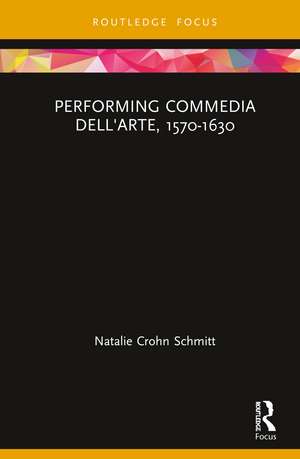Performing Commedia dell'Arte, 1570-1630
Autor Natalie Crohn Schmitten Limba Engleză Hardback – 9 oct 2019
Chapters include one on why, what, and how actors improvised, one on acting styles, including dialects, voice and gesture; and one on masks and their uses and importance. These chapters on historical performance are followed by a coda on commedia dell’arte today. Together they offer readers a look at both past and present iterations of these performances.
Suitable for both scholars and performers, Performing Commedia dell’Arte, 1570-1630 bears on essential questions about the techniques of performance and their utility for this important theatrical form.
| Toate formatele și edițiile | Preț | Express |
|---|---|---|
| Paperback (1) | 186.65 lei 43-57 zile | |
| Taylor & Francis – 30 iun 2021 | 186.65 lei 43-57 zile | |
| Hardback (1) | 335.96 lei 43-57 zile | |
| Taylor & Francis – 9 oct 2019 | 335.96 lei 43-57 zile |
Preț: 335.96 lei
Preț vechi: 385.58 lei
-13% Nou
Puncte Express: 504
Preț estimativ în valută:
64.29€ • 66.72$ • 53.74£
64.29€ • 66.72$ • 53.74£
Carte tipărită la comandă
Livrare economică 17-31 martie
Preluare comenzi: 021 569.72.76
Specificații
ISBN-13: 9780367085650
ISBN-10: 0367085658
Pagini: 120
Ilustrații: 22
Dimensiuni: 156 x 234 mm
Greutate: 0.34 kg
Ediția:1
Editura: Taylor & Francis
Colecția Routledge
Locul publicării:Oxford, United Kingdom
ISBN-10: 0367085658
Pagini: 120
Ilustrații: 22
Dimensiuni: 156 x 234 mm
Greutate: 0.34 kg
Ediția:1
Editura: Taylor & Francis
Colecția Routledge
Locul publicării:Oxford, United Kingdom
Public țintă
Postgraduate, Professional, and UndergraduateCuprins
List of figures; List of tables; Acknowledgments; Introduction; 1. Improvisation: why, what, how 2. Acting styles: dialects, voice, gesture; 3. The uses of masks; 4. Coda: commedia dell’arte today; Index
Notă biografică
Natalie Crohn Schmitt is Professor Emerita of Theatre and English at the University of Illinois, Chicago, USA. Her wide-ranging scholarship includes Befriending the Commedia dell’Arte of Flaminio Scala: The Comic Scenarios (2014) and essays on commedia dell’arte in New Theatre Quarterly, Viator, Renaissance Drama, and Text and Performance Quarterly. She is the recipient of two National Endowment for the Humanities fellowships and of Humanities Center fellowships at Stanford University and at the University of Illinois.
Recenzii
''Performing Commedia dell’Arte, 1570–1630 takes this method as its subject, exploring the practicalities of arte performance, and the social, cultural, and political contexts of Italian professional theatrical production, during its sixty-year ‘golden age’..... It is a masterclass in synthesising often disparate sources, and speaks to the innovative nature of what is no doubt an important book that makes a significant contribution to our understanding of this elusive theatre.'' Tom Roberts Exeter College, Oxford; Early Modern Literary Studies
''Natalie Crohn Schmitt’s new work makes a valuable addition to her previous Befriending the Commedia dell’Art of Flaminio Scala which highlighted dimensions of the commedia dell’arte often overlooked, with close readings that paid attention to Scala’s mastery of literary devices and rhetorical flourishes. In Performing Commedia dell’Arte, 1570–1630 she goes much deeper in her analysis of the means and methods the actors employed: improvisation, acting styles, and masks.'' Rosalind Kerr, University of Alberta; Renaissance and Reformation
''Natalie Crohn Schmitt’s new work makes a valuable addition to her previous Befriending the Commedia dell’Art of Flaminio Scala which highlighted dimensions of the commedia dell’arte often overlooked, with close readings that paid attention to Scala’s mastery of literary devices and rhetorical flourishes. In Performing Commedia dell’Arte, 1570–1630 she goes much deeper in her analysis of the means and methods the actors employed: improvisation, acting styles, and masks.'' Rosalind Kerr, University of Alberta; Renaissance and Reformation
Descriere
Performing Commedia dell’Arte, 1570-1630 explores the performance techniques employed in commedia dell’arte and the ways in which they served to rapidly spread throughout Europe the ideas that were to form the basis of modern theatre.
